Recent Articles
Popular Makes
Body Types
2021 Volkswagen Atlas Road Test and Review
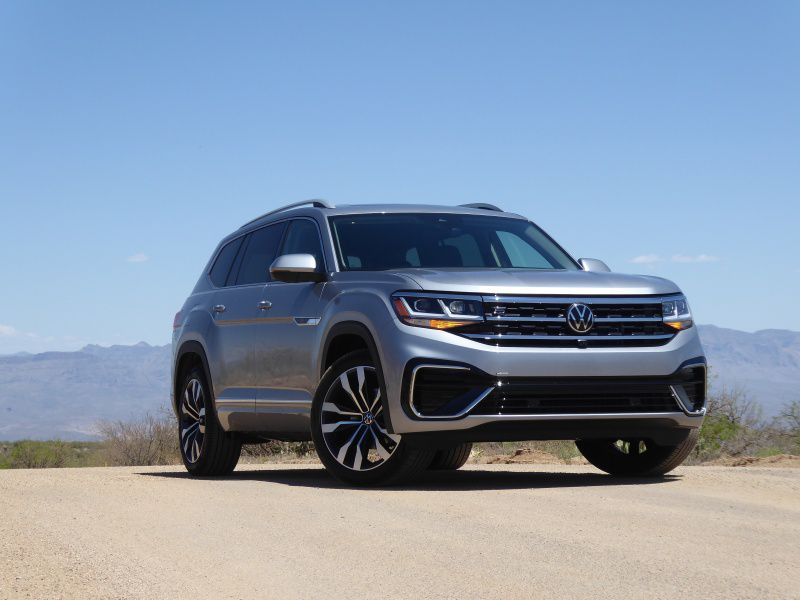
2021 Volkswagen Atlas ・ Photo by Ron Sessions
Many three-row midsize SUVs advertise seven-passenger seating, but few offer space for full-grown adults in the rearmost seats. Designed from the start for the North American market, the 2021 Volkswagen Atlas is one of the few SUVs featuring grownup-worthy headroom and legroom for passengers in all three rows, as well as dignified access to the third-row perches.
Now into its fourth year since its 2018 introduction, Volkswagen’s largest vehicle favors practicality over style. The tall and squarish Atlas stretches 16.7 feet from nose to tail and can swallow up to 96.8 cubic feet of cargo, nearly as much as the Toyota Sienna minivan can haul.
For 2021, the Volkswagen Atlas gets a refreshed appearance with a new three-bar grille similar to the one in the five-passenger Atlas Cross Sport, all-LED exterior lighting, plus updated infotainment and added Car-Net connectivity features. Otherwise, the 2021 Atlas is the same roomy six- or seven-passenger three-row midsize SUV it has been since its 2018 introduction.
The broad Atlas lineup (including the $1,020 destination charge) continues in 2021 with the base 4-cylinder S ($32,575), 4-cylinder SE ($35,925), SE w/technology ($37,965), V6-only SE R-Line ($40,765), SEL ($43,445), V6-only SEL R-Line ($45,045), 4Motion-only SEL Premium ($48,245), and range-topping V6/4Motion-only SEL Premium R-Line ($51,745). On S, SE, SEL trims, 4Motion all-wheel drive is a $1,900 upcharge over front-drive models.
Capacious and Functional Cabin
Inside, Volkswagen’s midsize SUV is quiet and roomy with simple, no-nonsense control layouts. For an SUV that can top out around $50,000, there’s a preponderance of exposed hard plastic, but what’s there is functional and durable. As long as you don’t expect Audi-like materials and finishes, it’s all good. If you want something more lux in this price and size class, try a Mazda CX-9.
The generously sized front bucket seats of the Atlas are firm yet comfortable with no hotspots and can accommodate a wide swath of body types. The base S comes with cloth seats and the range-topping SEL Premium is fitted with leather coverings. In all other Atlas trims, the seats are faux-leather-covered. All but the base S are equipped with a power driver’s seat as well as heat for both the driver and front passenger. SEL and higher trims add a power front passenger seat and memory controls for the driver’s seat. The front seats are ventilated in the range-topping SEL Premium.
Due to the big VW’s large windows and comparatively thin windshield pillars, the Atlas offers good outward visibility. Storage is ample courtesy of a huge, covered bin under the center console armrest, an open bin (with 12-volt and USB charge ports) forward of the shifter, a decent-sized glovebox, and big bins inside the doors.

Photo by Ron Sessions
Updated Infotainment
As with other switchgear in the Volkswagen Atlas, the infotainment system is intuitive to operate. The base S trim comes with a carryover MIB2 system and 6.5-inch color touchscreen that includes wired App-Connect smartphone integration and the ability to run Apple CarPlay and Android Auto. Audio with this system is a simple AM/FM stereo with six speakers.
All SE, SEL, and SEL Premium trims upgrade to Volkswagen’s latest MIB3 system with wireless Apple CarPlay and Android Auto cellphone mirroring and a larger 8-inch touchscreen. SEL and SEL Premium models go another step farther, adding embedded navigation. SE and SEL trims also get a 6-speaker AM/FM stereo augmented by HD Radio and a 3-month trial of SiriusXM with 360L, the latter adding the ability to combine satellite and streaming sources custom tailored to one’s listening preferences. Standard with the top-of-the-line Atlas SEL Premium is an immersive 12-speaker Fender premium audio system with a crystal-clear center speaker and thumping subwoofer.
All of the displays feature easy-to-use analog rotary volume and tuning knobs, with shortcut buttons for the most frequently used selections flanking the screen. All but the price-leader S model also come with a wireless phone charger plus enhanced voice recognition for making audio selections and more. Car-Net in-car Wi-Fi is available by subscription.
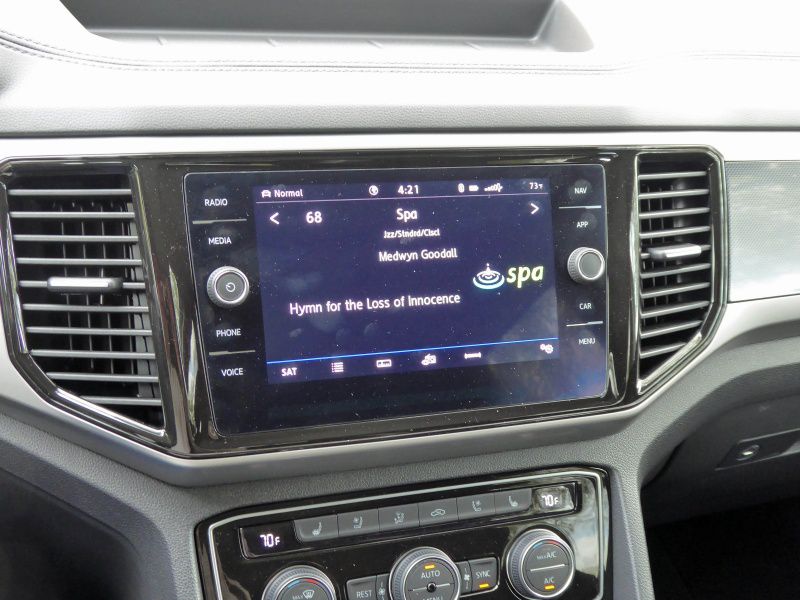
Photo by Ron Sessions
Reconfigurable Driver Display
The Atlas may be a bit on the plain and staid side, but the SEL trim and higher get a slick Digital Cockpit that allows the driver to choose from several different gauge layouts and a total of 21 customized viewing options. It definitely ups the cool factor in what otherwise is a straightforward, workaday cabin.
The driver display can range from a digital facsimile of the base analog tachometer and speedometer layout to one that has no speedometer or tachometer display, just an Audi-like full-width navigation map with small-font digital readouts for current speed and gear selected underneath.

Photo by Ron Sessions
Roomy Second Row
Moving aft to the second row, the tall roof affords generous headroom and the wide cabin means three adults can sit abreast on the standard bench seat without crowding each other. Legroom is generous as well, topping that available in the 2022 Nissan Pathfinder. The standard 60/40 split folding bench has individual seatbacks that recline up to 14 degrees. The second-row seat sections can also slide fore and aft up to 7.7 inches to accommodate different-sized passengers. SE and higher trims include a fold-down center armrest with cupholders for the bench seat as well as pull-up sunshades. All Atlas trims include separate climate controls for second-row passengers. The SEL Premium trim adds heated outboard second-row seats.
The second-row seat has anchors and tethers to latch up to three child safety seats. Also, any child seats installed in the second row do not have to be removed to tilt and slide the outboard second-row seats forward to gain access to the third row.
Individual second-row captain’s chairs are a $695 option for all trims except the base S and mid-level SE.
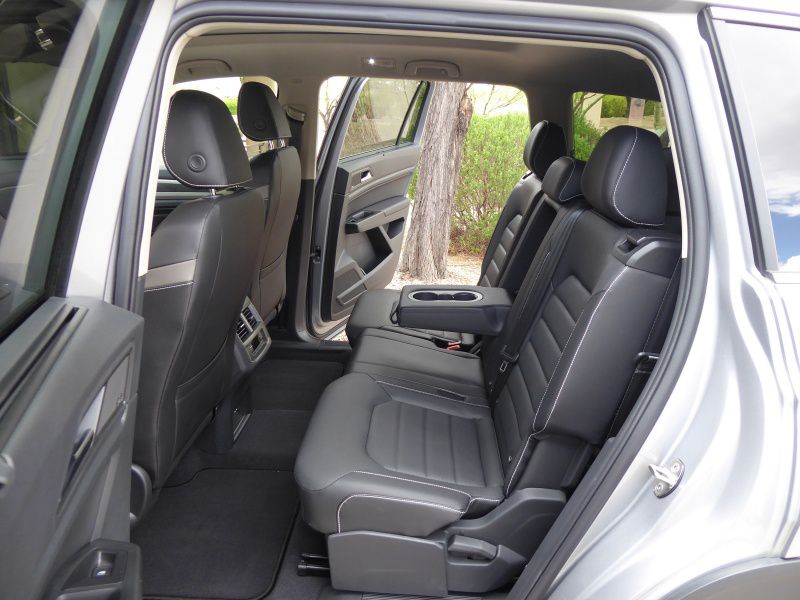
Photo by Ron Sessions
Third Row Not Just for Kids
The midsize Volkswagen Atlas proves that buyers don’t need to scale up to a huge Chevrolet Suburban or Ford Expedition just to get a third-row seat that’s suitable for more than just kids. With more third-row legroom than the Toyota Highlander, Nissan Pathfinder, Honda Pilot, Ford Explorer, Kia Telluride, and Chevrolet Traverse, the Atlas can handle a pair of six-foot-tall adults back there with relative comfort even on longer drives.
The third-row seatback is split 50/50 allowing flexibility to carry a single passenger while folding down the other side to accommodate more cargo and bulky items. A one-handle tilt-and-slide feature of the standard second-row bench seats opens up space for easy pass-through access to the third row.
The third-row seat headrests can be recessed nearly flat with the tops of the seatbacks when not in use, greatly improving rearward vision for the driver.
As with the first and second rows, the third-row passengers get their own adjustable air vents.
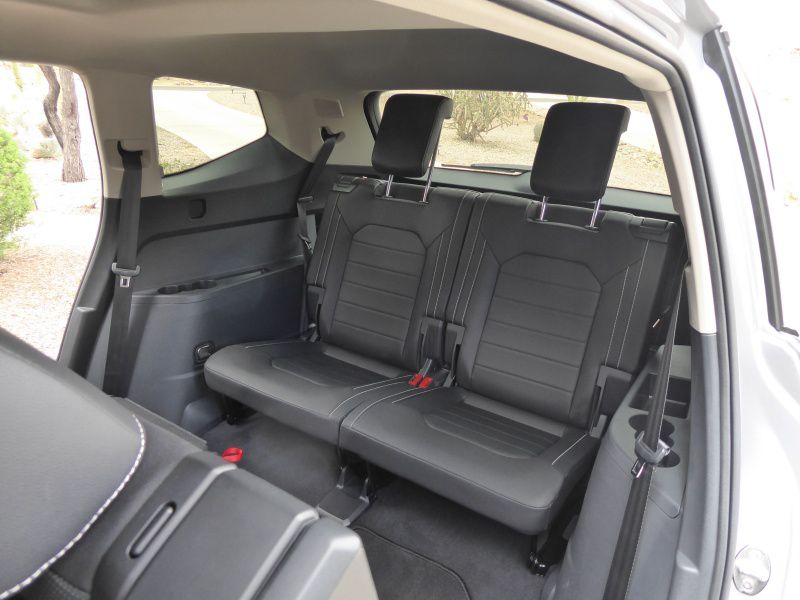
Photo by Ron Sessions
Huge Cargo Hold
The big, made-in-Tennessee Atlas offers an abundance of cargo space for the largesse Americans tend to haul around. Behind the third-row seat, there’s a full-size sedan-like 20.6 cubic feet of space, room for four or five airport roller bags. Fold the second- and third-row seats flat and a minivan-like 96.8 cubic feet of stowage space opens up. The Atlas has more cargo space than other three-row midsize SUVs such as the Nissan Pathfinder, Toyota Highlander, Ford Explorer, Honda Pilot, and Kia Telluride.
Additional storage for small items and valuables such as a laptop, purse, or camera is available under the cargo floor adjacent to the spare tire.
Entry into the cargo area of the Atlas is with a manually operated liftgate on base S trim. The liftgate is power-operated on SE models. A hands-free liftgate, opened with a foot wave beneath the rear bumper, is standard in SEL and SEL Premium trims as well as in SE models with Technology trim.
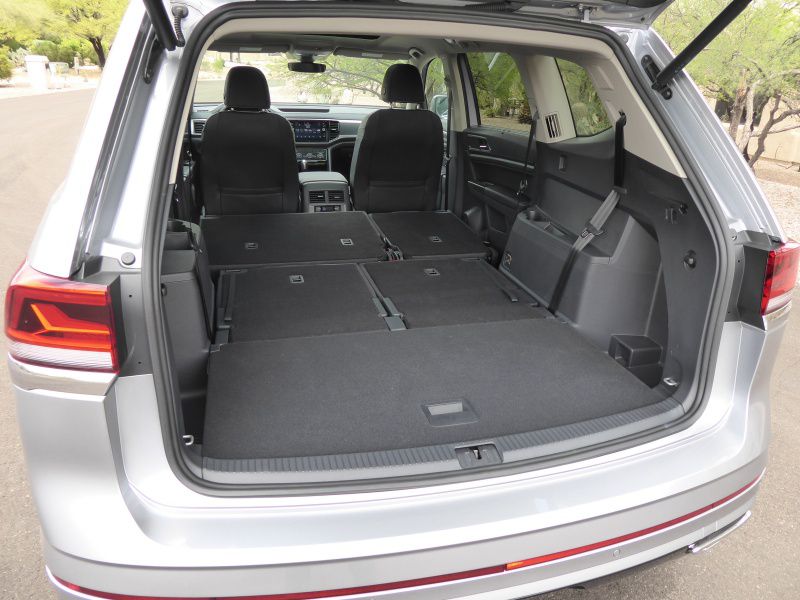
Photo by Ron Sessions
Choice of Powerplants
The Atlas offers two engine choices, a 2.0-liter 4-cylinder turbo with 235 horsepower and a naturally aspirated 3.6-liter punching 276 hp. On the face of it, the higher output of the V6 would seem to make it the performance choice for the big, roomy Atlas. But the plot thickens here because the V6 makes its peak power at a lofty 6200 rpm and doesn’t reach its maximum 266 lb-ft of torque until it’s revved to 3500 rpm. The turbo 4-cylinder, on the other hand, generates its 258 lb-ft of torque at a just above-idle 1500 rpm, making it much more accessible in everyday traffic.
If the majority of your driving is commuting and around-town, the 2.0-liter 4-cylinder turbo is punchier and more responsive in traffic. If, on the other hand, you plan on taking advantage of the higher towing capacity (5,000 pounds with the V6 versus just 2,000 for the 4-cylinder), or do a lot of highway driving where top-end passing ability is prized, go for the V6.
Not only is the 4-cylinder turbo more responsive around town, it’s also considerably more fuel efficient than the V6. The 2.0-liter turbo four is EPA-rated at 20-21 mpg city/24 mpg highway/22 mpg combined whereas the V6 arrives at 16-17 mpg city/22-23 mpg highway/18-19 mpg combined.

Photo by Ron Sessions
Available 4Motion All-Wheel Drive
If you live in an area where the added traction of 4Motion all-wheel drive is a necessity, the good news is that it’s now also available with the 4-cylinder turbo, not just the V6 as before. 4Motion is an on-demand system that defaults to front-wheel drive under low load or coasting conditions, ramping up to all-wheel drive with as much as 50% of drive torque allocated to the rear wheels if the system senses that the front wheels are starting to slip.
Included with 4Motion is Active Control which enables drivers to choose from a wide variety of driving modes. The basic settings are Onroad, Snow, Offroad, and Custom Offroad. Within the Onroad setting, the driver can further customize the tuning of the throttle response, transmission shift timing, steering effort, and adaptive cruise control parameters with selectable Normal, Comfort, and Sport settings.
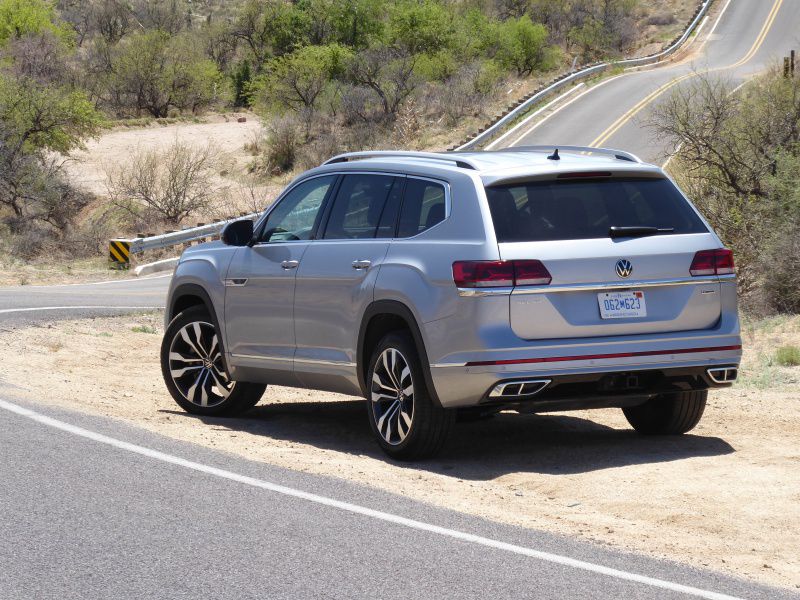
Photo by Ron Sessions
IQ.Drive Advanced Driver-Assistive Tech
All 2021 Atlas trims feature IQ.DRIVE driver-assistance tech consisting of a standard forward collision warning system with pedestrian detection and auto emergency braking, plus blind spot and rear cross traffic alert systems. The mid-level SE with Technology trim brings adaptive cruise control as well as park distance control which beeps more intently as the Atlas gets closer to an obstacle. Moving up to SEL trim adds dynamic road sign display, automatic high beams, lane-keep assist, and an active blind-spot monitor that can make small steering corrections if the system’s warnings are not heeded. Opting for the top SEL Premium trim adds a 360-degree overhead-view camera to replace the standard back-up camera as well as park assist that can steer the big Atlas in and out of a parallel parking space.
New for 2021 in SEL and higher trims is Travel Assist which combines adaptive cruise and lane keeping for semi-autonomous, hands-on driving on well-marked highways and Emergency Assist which brings the Atlas to a gradual stop if the driver is incapacitated.
The National Highway Traffic Safety Administration gives the 2021 Atlas its top 5-star rating overall, with five stars for side impacts and four for front impacts and rollover resistance. The Insurance Institute for Highway Safety rates Atlas crashworthiness as Good in all categories but gives the non-curve-adaptive headlamps in S and SE trims a Marginal rating.
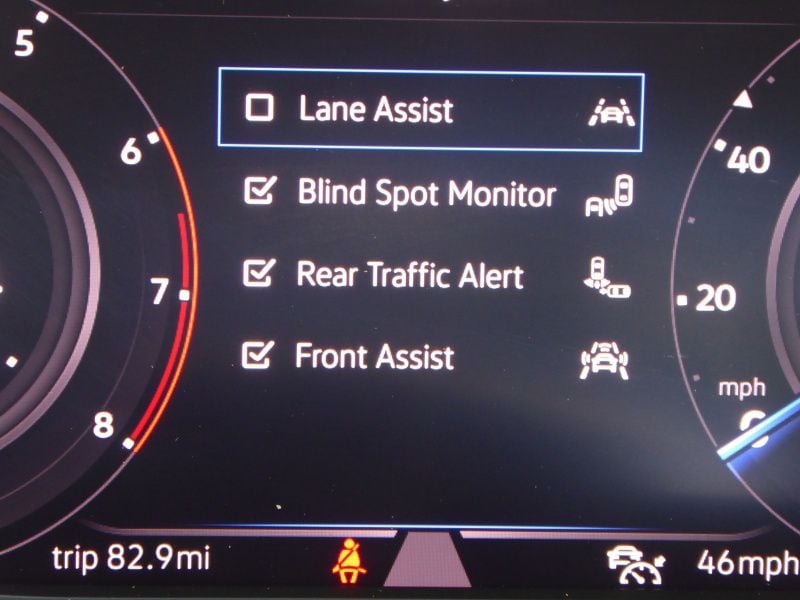
Photo by Ron Sessions
Room to Roam
Built in America for Americans, the 2021 Volkswagen Atlas is a great choice for buyers who want the ability to carry seven adults as well as plenty of cargo in comfort without the “soccer mom” stigma associated with driving around in a minivan or a full-size SUV that won’t fit in the garage.
Despite its jumbo appearance and capacious interior, the Atlas drives smaller than it looks. Especially with the R-Line’s grippy 21-inch rubber, it offers pinpoint steering precision and crisp, fade-free brake response. Body movements are well-damped even over pitchy pavement and body roll kept to a minimum in turns. The Atlas’s 8-speed transmission shifts are quick and positive.
The Atlas is geared for big families with big plans, combining the roominess and value Americans like with driving refinement expected of a European brand.
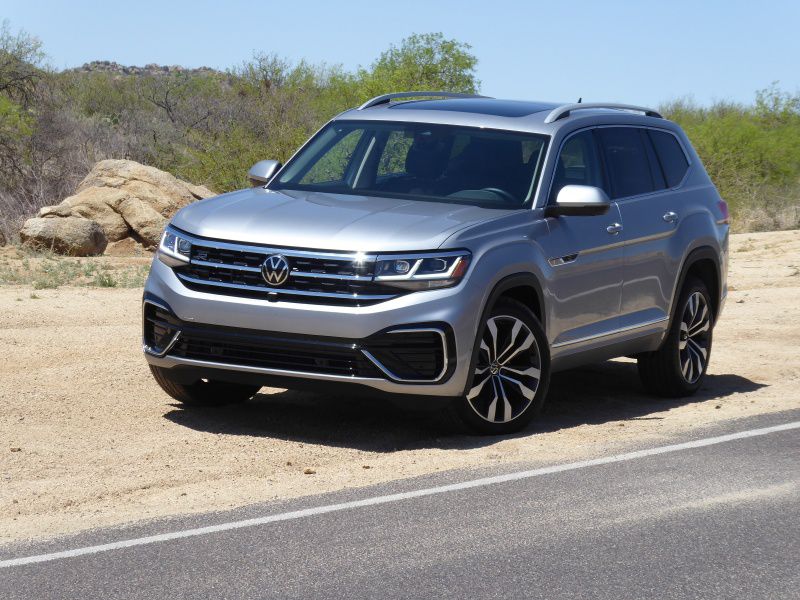
Photo by Ron Sessions